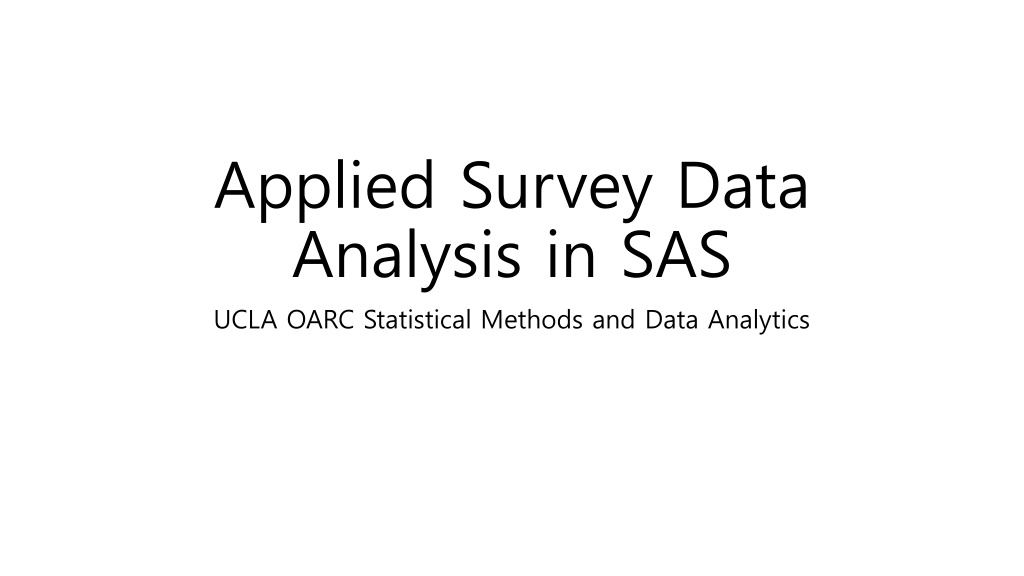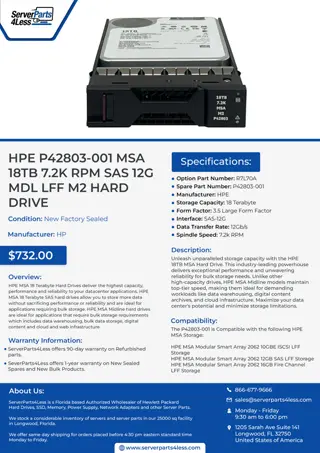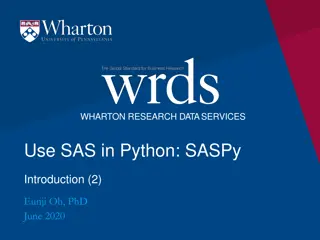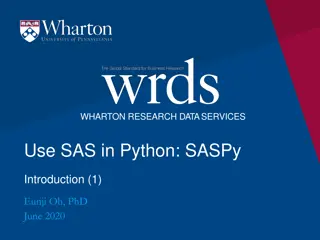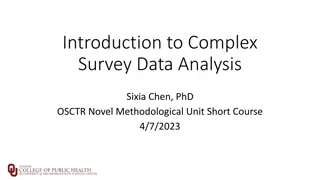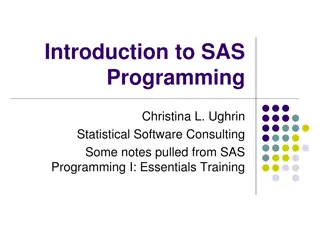Understanding Survey Data Analysis in SAS: Methods and Applications
Explore the nuances of survey data analysis in SAS, covering topics such as populations and samples, complex survey samples, stratified sampling, and more. Learn how to ensure representativeness in sampling and optimize precision of estimates in survey studies.
Download Presentation

Please find below an Image/Link to download the presentation.
The content on the website is provided AS IS for your information and personal use only. It may not be sold, licensed, or shared on other websites without obtaining consent from the author. Download presentation by click this link. If you encounter any issues during the download, it is possible that the publisher has removed the file from their server.
E N D
Presentation Transcript
Applied Survey Data Analysis in SAS UCLA OARC Statistical Methods and Data Analytics
Outline Populations and samples Complex survey samples Statistical analysis of complex survey samples NHANES 2011-2012 demographics data Complex survey data analysis in SAS
Populations and samples With statistics we estimate quantities and make inferences for a population, a complete set of units People in the US Retail stores in California Intersections in Los Angeles Usually can t measure the whole population, so take a sample Sample must be representative for unbiased estimation and accurate inference How to achieve representativeness? 3
Simple random samples (SRS) Selects population units with equal probability Representative of the population in the long run Simplest statistical analysis Can be prohibitively costly or impractical Hard to reach population elements Small subpopulations underrepresented or absent 4
Survey samples Surveys are relatively inexpensive so studies often use large samples Rarely are SRS Instead, use sampling strategies try to maximize precision of estimates while minimizing costs Stratification Oversampling Clustered sampling Often use multistage sampling designs Randomly sample larger aggregates of units first then individual units are sampled at final stage 6
Stratified sampling 1. Population divided into mutually exclusive strata, groups of similar units Common stratification variables: geographic region, race, age, education Ensures some members of small strata are sampled Units are typically randomly sampled within strata Strata sample sizes may be proportional to their size in the population Representative Or strata sample sizes may be disproportional Non-representative due to unequal probability of selection Oversampling of small subpopulations 2. 7
Oversampling Oversampling produces larger samples of small subgroups (strata) Key interest in the small subgroup or subgroup is very different from rest of population e.g. sampling billionaires to estimate total wealth of US Weights are used to make the sample representative of the population 8
Clustered sampling Clusters of units are randomly sampled first, then eventually individuals within clusters Multi-stage designs e.g. counties -> households -> individuals Generally reduces costs Generally reduces precision of estimates Units within clusters are correlated on many variables Less independent information
Statistical analysis of complex survey samples
Complex survey sample design effects Each of the discussed sampling design strategies can affect estimation of population quantities Many survey samples combine these strategies Stratified, multi-stage designs are commonly used Failure to account for design elements can result in biased estimates and standard errors *Image from Heeringa, West & Berglund (2010).
Complex survey weights Weights are used in statistical analysis of complex survey data to make the sample representative of the population Often, a final weight is calculated that accounts for: Unequal probabilities of selection Unequal probabilities of non-response Poststratification adjustments to meet population totals after sampling Final weight value interpreted as number of people in the population that the observation represents Sum of weights estimates population size Using weights generally decreases precision (increase standard errors) compared to SRS
Estimates and uncertainty with complex survey weights Weights affect both the point estimate of a parameter and its uncertainty (standard error) With weights, standard errors cannot be calculated the typical way as in SRS, so Taylor series linearization is used to approximate them Requires strata and cluster identifiers if used Alternatively, replication methods can be used to approximate variances Several sets of weights are released to mimic resampling/replication Replicate weights are increasingly used in place of cluster and strata identifiers to protect individual identities
Estimation with stratified and clustered samples Stratified sampling and estimation can increase precision by removing variation across strata To estimate average weight of individuals, can stratify by sex Parameter and standard error are estimated within each stratum Standard errors will be small within strata because of homogeneity Stratified estimates and standard errors are averaged together for final estimate Clustered sampling generally decreases precision compared to SRS due to less independent information
Design effect Design effect summarizes how all design elements affect precision of estimation Ratio of variance of parameter accounting for complex survey design to variance assuming SRS ? =??????????? ??????? Usually, ? > 1 Often reported by statistical software
Look for design variables in survey documentation Most survey documentation will describe the complex sampling design and identify key variables Weights Strata identifiers Cluster identifiers Look for words like sample design and variance estimation Some documentation gives statistical software code to use to account for design elements
NHANES 2011-2012 demographics data
NHANES 2011-2014 objectives National Health and Nutrition Examination Survey Primary objective: produce descriptive health and nutrition statistics for various sex, race/ethnicity, and age subdomains of US population Includes a questionnaire/interview and medical exam Survey population: noninstitutionalized US civilians For this workshop, we will use a data set of demographics for respondents interviewed in 2011-2012
NHANES 2011-2014 Sample design Description of sampling plan: Look in Sample Design section Stratified, multistage sampling design Stratified by state-level health (death rate, infant mortality rate, etc.) and urban- rural population distribution 4-stage design First-stage primary sampling unit (PSU) is county Second stage is census blocks, third stage is households, fourth is individuals Oversampled Hispanic, black, and Asian people as well as low-income white people and adults over 80
NHANES 2011-2012 data set and documentation Data download page: Click DEMO_G Data [XPT-3.6MB] link to download SAS XPT file Use libname and data step to import data into SAS Data documentation (including codebook) Design variables WTINT2YR sampling weight Includes adjustments for unequal probability of selection, nonresponse, and poststratification adjustments to meet population totals from the American Community Survey (US Census Bureau); see the Estimation Procedures guide for more information SDMVPSU Primary sampling unit (cluster) variable SDMVSTRA strata variable
Complex survey data analysis in SAS
SAS PROCs for complex survey data 7 SAS procedures dedicated to analysis of complex survey data PROC SURVEYMEANS: descriptives for continuous variables PROC SURVEYFREQ: frequency tables for categorical variables PROC SURVEYREG: linear regression PROC SURVEYLOGISTIC: logistic regression PROC SURVEYPHREG: Cox proportional hazards models PROC SURVEYSELECT: selecting a probability sample from a data set PROC SURVEYIMPUTE: imputing missing values (not multiple and not model-based)
Specifying design variables Each of the survey PROCs have the following statements to specify design variables: WEIGHT STRATA CLUSTER Simply specify the corresponding design variable on each statement Most PROCs also include a REPWEIGHTS statement to specify a set of replicate weights for standard error estimation Generally, Taylor series linearization will be used to estimate standard errors unless REPWEIGHTS is used
PROC SURVEYMEANS For means, variances, quantiles, etc. of numeric/continuous variables PROC SURVEYMEANS statement options include: mean, min, max, range for mean, minimum, maximum and range percentile=(values) for percentiles at list of values nmiss for number missing df for degrees of freedom cv for coefficient of variation deff for design effect for standard errors of mean VAR statement: specify variables to analyze
PROC SURVEYFREQ For weighted one-way frequency tables and multi-way crosstabulations Weighted frequencies are estimates of subpopulation sizes TABLES statement: specify variables to analyze Use * between variables for cross-tabulations Options: row, col for row and column percentages deff for design effect for standard errors of percentages expected for expected cell frequencies assuming independence Design-adjusted ?2 tests chisq for Rao-Scott ?2-test lrchisq for Rao-Scott likelihood ratio ?2-test wchisq for Wald ?2-test wllchisq for Wald log-linear ?2-test
DOMAIN statement For subpopulation analysis, use the DOMAIN statement rather than BY or WHERE Using the DOMAIN statement will properly account for uncertainty in the size of subpopulations Standard errors may be incorrect if you don t Specify one or more grouping variables after DOMAIN Analysis will be run on each group e.g. DOMAIN RACE*EDUC in PROC SURVEYMEANS will calculate means for each group formed by crossing race and education Or, specify a formatted value in parentheses and quotes after the variable to restrict analyses to just that group e.g. DOMAINRACE( white )*EDUC( HS or less ) to run analyses only on whites with less than high school education
PROC SURVEYREG Linear regression models Somewhat more similar to PROC GLM than PROC REG Includes LSMEANS, ESTIMATE, and CONTRAST statements not found in PROC REG On the MODEL statement, we will include option SOLUTION to produce a table of parameter estimates True likelihoods are not estimated with survey data, so most likelihood based statistics (e.g. AIC, BIC) not available
PROC SURVEYLOGISTIC Binary, ordinal, and multinomial logistic regression models Similar to PROC LOGISTIC, but lacks ODDSRATIO and ROC statements Odds ratio tables are produced by default True likelihoods are not estimated
PROC SURVEYIMPUTE Impute missing values by replacing them with observed values Not model-based, but instead, define cells of similar observations Cells defined by grouping variables like age, gender, health variables Observations with missing on a variable will have value replaced by value from donor within the same cell Hot-deck imputation e.g. if missing on income, define cells by age and education; an observation with missing on income will have value replaced by donor with same age and education CELLS statement used to specify variables that define cells VAR statement used to specify variables to impute OUTPUT statement used to name single imputed dataset (with OUT=)
References Chen TC, Parker JD, Clark J, Shin HC, Rammon JR, Burt VL. (2018) National Health and Nutrition Examination Survey: Estimation procedures, 2011 2014. National Center for Health Statistics. Vital Health Stat 2(177). Heeringa SG, West BT, Berglund PA. (2010). Applied Survey Data Analysis; Chapman Hall. Johnson CL, Dohrmann SM, Burt VL, Mohadjer LK. (2014). National Health and Nutrition Examination Survey: Sample design, 2011-2014. National Center for Health Statistics. Vital Health Stat 2(162).
